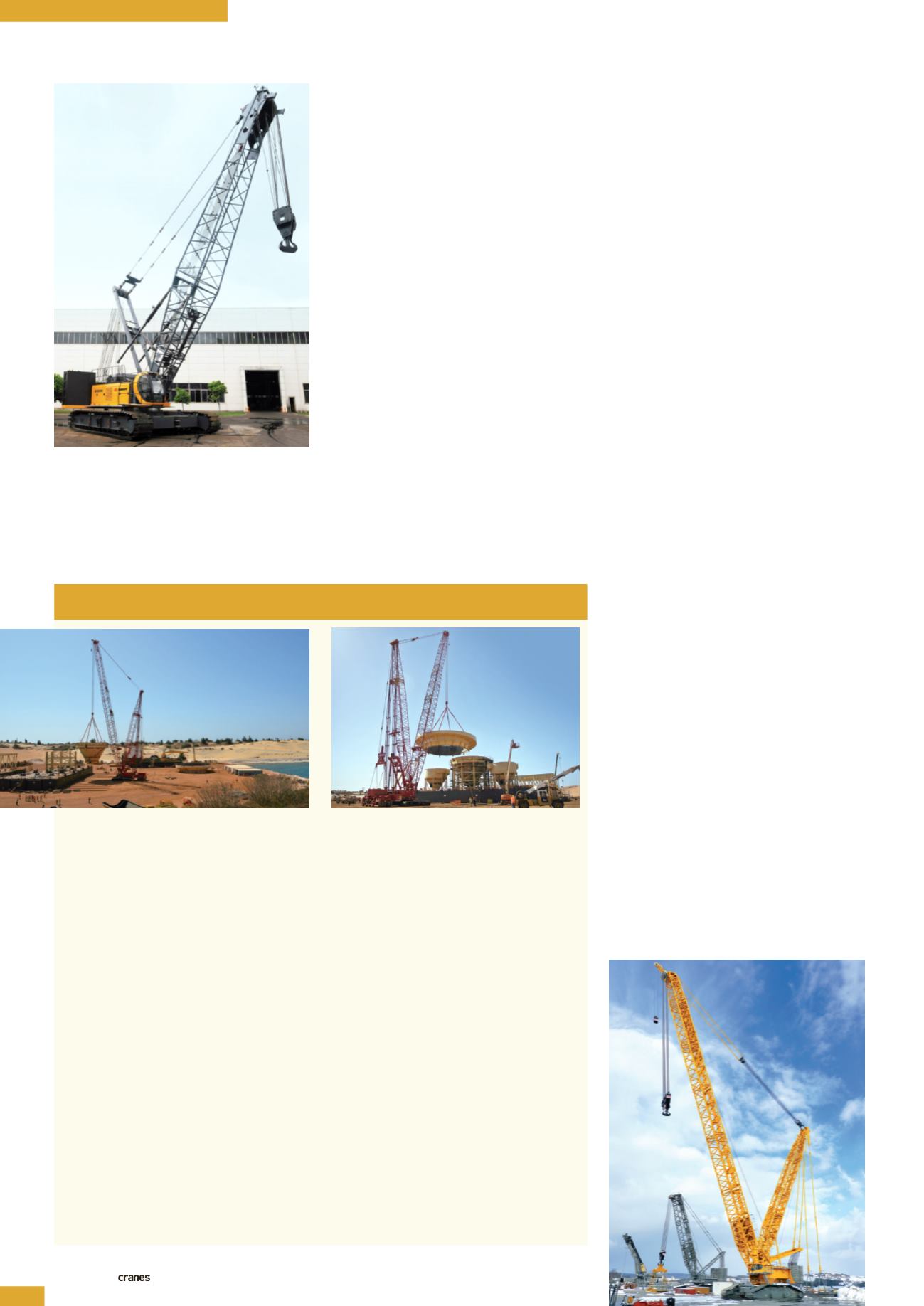
CRAWLER CRANES
INTERNATIONAL AND SPECIALIZED TRANSPORT
■
OCTOBER 2013
16
A Manitowoc 2250 crawler crane is helping build one of the largest mineral sand mines in the
world in the sand dunes of Senegal, Africa.
The main contractor and mine manager of the site, Grande Côte Operations, purchased the
450 tonne capacity crane to help install the dredge, surge bin and pontoons that will make up the
mineral processing plant at the mine.
The pontoons weigh 120 tonnes and are 29 metres long, 5 m wide and 4.5 m high. For the
installation of the surge bin, the 2250 lifted the unit in three sections. In total the unit weighs 225
tonnes. The largest section weighed 87 tonnes and was lifted at 22 m radius.
Jason Eade, lifting services superintendent at the site, said, “We have been planning these
lifts for two years and it’s great to finally see the crane perform so well. It is working perfectly in
demanding conditions and the project is progressing exactly as planned.”
For the lifts the crane was fitted with the Max-Er attachment to increase its standard 272
tonne capacity to 450 tonnes. With the addition of a Ringer attachment, the crane can lift 1,300
tonnes. The crane has been configured with a 91 m heavy lift boom, which can be extended to 184
m with a luffing jib extension.
The 400 square kilometre Grande Côte Mineral Sands Project, which is costing approximately
US$570 million, is on a mobile dune system. To deliver the crane to the site it was shipped
from the USA to Dakar, before being transported 145 km north to the site in 29 truckloads.
The crane will remain at the project until it is completed in the second half of 2013, a company
spokesperson added.
The Grande Côte Mineral Sands Project will be used to separate heavy minerals from the
lighter quartz sand. Over its forecast 20 year life, the mine will produce approximately 575,000
tonnes of limonite and 85,000 tonnes of zircon each year.
MANITOWOC CRAWLER ON $570 MILLION
MINE IN SENEGAL
product director at Manitowoc, describes
it, “This self-rigging crane is very easy to
assemble and disassemble. It can install and
remove its own counterweights and tracks
without the need of a support crane. In
addition, it has a three metre component
width and modular assemblies for easy
transport over the road.”
Steven Dick, technical sales support
co-ordinator at Manitowoc, explains, “Our
engineers designed the MLC165 to facilitate
general contractor activities like pile
driving and moderate clamshell or grapple
work. We like to think of the MLC165 as a
versatile tool.”
The MLC165 has a maximum boom
length of 84 m and optional fixed and
luffing jibs. The maximum boom and fixed
jib length is 93.4 m and the maximum
boom and luffing jib reach can be increased
to 102.8 m.
Also new to the crawler crane market is
the 248 HSL from Link-Belt. The new 200
US ton (181 tonne) crawler offers a range of
boom systems, including a main boom with
a maximum length of 86.87 m, a fixed jib
with a maximum length of 30.48 m,
a luffing boom with a maximum length
of 48.77 m and a 54.86 m luffing jib. The
counterweight can be removed.
“The HSL line of Link-Belt lattice
crawlers represents our next generation
of HYLAB cranes, which Link-Belt first
introduced over twenty five years ago,”
Pat Collins, Link-Belt senior product
manager, lattice crawler and telescopic
crawler cranes explains. “The 248HSL joins
the 238 HSL and the recently upgraded
298 HSL in the mid-range 150 to 250 ton
market. It has been built for general lifting
duties including tilt wall, bridge work, steel
erection and pile driving to name a few. ”
Sany has also introduced some new
crawler crane models to the market,
including the SCC8500. Suited for
jobs in the energy and infrastructure
market, the crawler has 10 possible boom
configurations for main boom, fixed jib
important and all our crawlers come with
the fall protection system.”
Efficiency and versatility are other
factors influencing the design of crawler
cranes. Part of this development is due to a
shift in work type and job sites for crawlers,
as a spokesperson from Manitowoc
explains, “Crawler cranes are often called
upon not just to lift but to travel while
carrying a large load. One of the most
interesting crawler crane applications
are barge work, where a crawler crane is
installed on a special platform on a barge
for use at sea. Such barge cranes perform
material handling, installation and general
construction work.”
“With rental rates being pushed by
construction and rental companies having
their profits tightened profitability is
really important. As a result efficiency
and versatility are driving crawler crane
development,” Jakobs says.
New models
Examples of how efficiency and versatility
have driven crawler crane development
can be seen in a number of the new crawler
cranes that have entered the market this
year. From manufacturer Manitowoc, for
example, is the 165 tonne capacity MLC165
lattice boom model, which is designed for
contractors and rental houses in the
global market. Jerry Maloney, global
The Manitowoc 2250
crawler crane on site
The heaviest lift
weighed 87 tonnes
>
The 1,000 tonne capacity
Liebherr LR 11000
The Sany SCC8150
crawler crane


